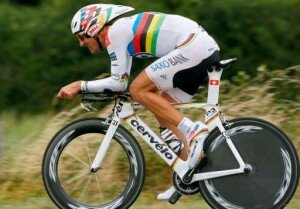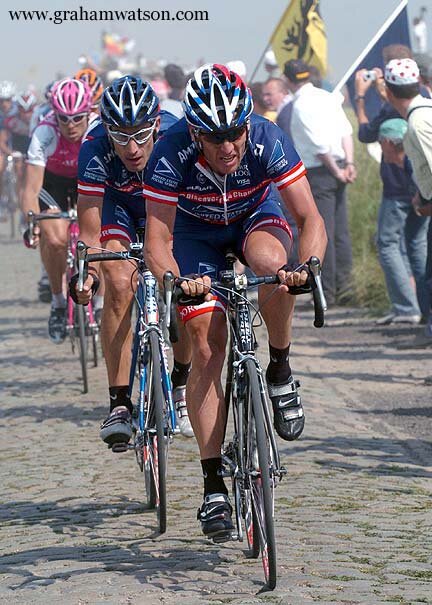October 21, 2009 by Irish Peloton
That is one crazy Tour route!
The route for the 2010 Tour de France was unveiled last week by Tour director Christian Prudhomme. The major talking points are that there is no team time trial, the Col de Tourmalet will be climbed twice and there will be 13.2 kilometres of cobbles on Stage 3. Despite there being some interesting aspects to the route, I can’t help but feel a little disappointed. Too many of the mountain stages end in a long descent to the finish, which usually neutralises the specialist climbers and doesn’t really do enough to shake up the General Classement. The route needs more mountain top finishes. In last year’s Tour, of the road stages it was only those with finishes at a summit where the favourites gained and lost significant time.
Stage 9 last year, which included the climbs of the Col d’Aspin and the Col de Tourmalet, finished with a descent and a flat run into the finish. This almost culminated in Oscar Freire winning a Pyreneean mountain stage when he won the bunch gallop for third spot 34 seconds behind a two man breakaway. If the stage had finished on the top of the Tourmalet, the big guns would have had to show themselves which would have led to more exciting racing. This disrespect of the Col de Tourmalet has been addressed this year but in total there are only three summit finishes. These three stages, along with the final 51km time trial, as far as I can see are the only realistic opportunities for the main contenders to distance each other. Four stages out of twenty-one? I feel cheated. Not to mention the fact that Alpe d’Huez has been ignored for 2 consecutive years for the first time since it’s Tour début in 1976 (although it will appear as a summit finish in next year’s Dauphiné Libéré).

Lance Armstrong leading George Hincapie and Jan Ullrich over the pavé the last time they appeared on the Tour route in 2004.
The lack of a team time trial means that riders like Cadel Evans and Denis Menchov will not be victims of their inept teams and will probably still be in contention after the first week. Although one suspects Menchov will have to spend a bit of time over the winter learning how not to fall off his bike (he’s even crashed whilst riding uphill before).
The cobbles on Stage 3 are intriguing and besides the four stages I mentioned already, they provide the only other possibility where the G.C. contenders might gain some time on their rivals. The cobbles only stretch for a total of 13.2 kilometres on the stage but most of the favourites could struggle to cope. Of the main protagonists, Contador, Schleck, Evans, Menchov and Valverde have all never ridden a cobbled race. Armstrong rode and finished the Tour of Flanders twice during his Tour winning years. By far the most experienced Tour contender on the cobbles is Bradley Wiggins, who throughout his career has ridden all the major cobbled races. As the saying goes, the Tour won’t be won here, but it could certainly be lost. Some bad weather and a lapse in concentration, the slippery cobbles could strike and one’s Tour could be over. The favourites will have to rely heavily on their more experienced team mates to get through all the way to the Arenberg forest unscathed. Don’t be surprised to see some unfamiliar names on the startlists of some cobbled classics next Spring.
So while there will be some interesting stages I do think that the route isn’t very conducive to exciting racing. So what would I do if I was in Christian Prudhomme’s shoes and given licence to design the Tour I’ve always wanted? Bear with me on this because it’s a little bit outrageous. I would have six mountain top finishes, three in the Alps and three in the Pyrenees. This would give the specialist climbers a good opportunity to distance themselves from those more inclined towards the time trial, for whom, I would have one individual time trial. A pan flat 110km course scheduled for the penultimate stage. Think about it, it would make the entire race engrossing.

Could Fabian Cancellara conceivably win the Tour with the addition of a 110km time trial?
Riders like the Schlecks, Robert Gesink, Carlos Sastre and Alberto Contador would have to constantly attack in the mountains to take as much time as possible from those who would excel in such a long time trial. Perhaps such a route might be perfect for Wiggins or Armstrong, or indeed Contador who seem to able to juggle the two disciplines to good effect. But who’s to know how each will perform in a time trial of such length, none of them would have ridden against the clock for so long a distance before. The last occasion a time trial even close to this distance was included in the Tour was 1987 when there was an individual test of 87.5km, although it appeared relatively early in the race on Stage 10 (won by Stephen Roche).
Having so many mountain top finishes and the mammoth time trial towards the end of the race would introduce a whole host of new contenders for the Tour. Riders who can suck wheels admirably in the mountains but who generally fail to make the final selection, but who also excel at time trials would suddenly find themselves capable of challenging. Enter new Tour contenders, Fabian Cancellara, Tony Martin, David Zabriskie, Andreas Kloden, Levi Leipheimer, David Millar, Gustav Larsson. The monstrous time trial would provide extra incentive for these riders to reduce their deficits in the mountains as much as possible. The permutations of who will attack, when and where are boundless.
Perhaps such an unusual format will never be given a chance by a Tour director. But I really feel that Prudhomme hasn’t set the stage for an exciting race. We should be prepared for a lot of stages dominated by breakaways with the Tour remaining stagnant through the Alps and only coming to life in when we finally reach the Pyrenees on Stage 14.


Leave a Reply